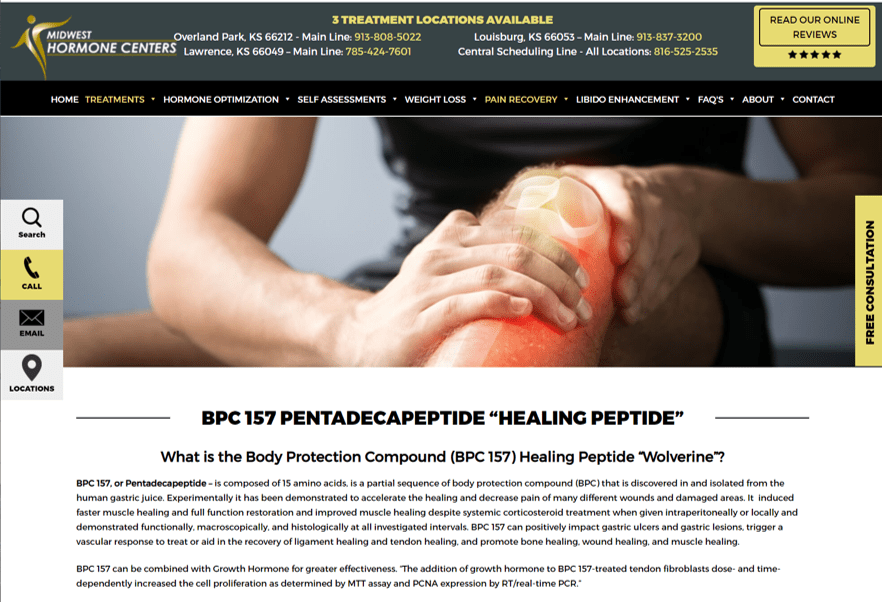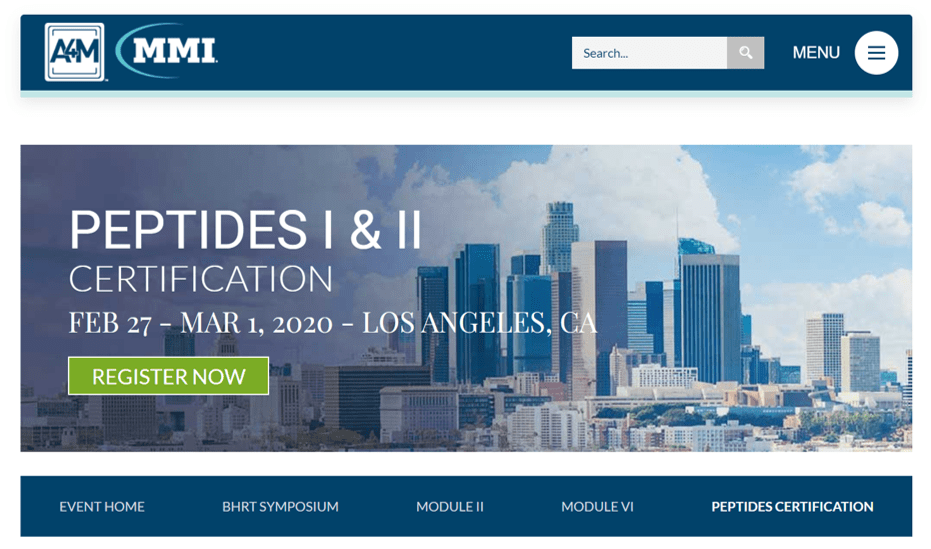What Are Peptides?
I have been bombarded this past year with questions about peptides. What are peptides? What are they used for? Do I recommend them to my patients? So let’s dig in on this topic.
What Are Peptides?
Peptides are merely small fragments of proteins. Basically, they are a compound consisting of two or more amino acids, which are the building blocks of all proteins. That’s the chemical definition, but In the context of the term we’re using here, this is a catch-all word that refers to several peptides that are being sold as nutritional supplements or for “research use only” that are being used by athletes and patients for anti-aging and to heal injuries.
BPC-157
Now that I’ve answered the “What are Peptides” question, what are some of the more common ones being sold? BPC-157 is the peptide I get asked about most often. What is it? What could it help? What’s the research?
BPC 157 is composed of 15 amino acids and is a partial sequence of the body protection compound (BPC) that was discovered in and isolated from human gastric fluid. While the compound has been shown experimentally to help different types of wounds heal, here I’ll focus on its musculoskeletal applications (1). Hence, let’s dive into what’s known about this compound and tendon healing.

In one study, BPC-157 was shown to help tendon fibroblast cells (tenocytes) survive an inflammatory challenge and increase their migration (2). However, we need to be VERY CAUTIOUS about these results. Why? From looking at the reported data in the paper, BPC-157 worked no better than the high dose platelet-rich plasma (PRP) that our lab research group tested in another study (3). Those diagrams from each paper are above (BPC-157 on the left and PRP on the right).
Hence, why would I expose my patient to the risks of an unknown compound that has never been tested rigorously in humans when I can get the same results with PRP which has been tested for orthopedic applications in dozens of randomized controlled trials in humans? Because I can store a vial of lyophilized BPC-157 powder in a vial on the shelf? That’s not a good enough reason for me.
BPC-157 and Ben Greenfield
Ben is a “biohacker” (shown above) which means that he’s someone who injects all sorts of stuff into his body, most of which is experimental and some of it illegal. He came on my radar when he had someone inject stem cells into his penis. Ben is keen on using BPC-157 so you can heal “like Wolverine”. For me, that’s not exactly a ringing endorsement.
How are Peptides Being Sold? Can You Buy BPC-157?
BPC-157, like all peptides used for these purposes, is in a regulatory “questionable” zone. Let’s explore how people are accessing this stuff.
Supplements
There are companies (like the one below) selling BPC-157 as an oral supplement. This makes some sense, as it can survive at least 24 hours in gastric acids (which is where it normally lives). Sadly, I was unable to find a single human trial of taking BPC-157 orally, so we have no idea if this stuff works.
Research Use Only
Another loophole for BPC-157 is that it’s sold as a lyophilized powder for reconstitution as “Research Use Only”. With company names like “Peptide Pros” and disclaimers like this one:
“Our USA peptides are not to be injected and are not intended for bodybuilding or tanning purposes of any kind. They are NOT for use as food additives, drugs, cosmetic, household chemicals, or other inappropriate applications. YOU MUST BE A MINIMUM OF 18 YEARS OF AGE TO ORDER FROM THIS SITE”
What could go wrong? Meaning, what you don’t see here is any verification that you are a researcher before buying these products. In addition, the problem with these websites is that given their number versus the number of publications, the entire world’s supply needed for research could likely be satisfied in one day’s worth of sales. Hence, these sites, despite protesting that the compound should only be used for research, in my opinion, likely know at some level that this compound is being used for human therapies.
USADA
This is from the US Anti-doping Agency, a resource for athletes to help them avoid being nailed for illegal drug enhancement (4):
Are Peptides Illegal? Is BPC-157 legal?
There appears to be no legal basis for selling BPC-157 as a drug, food, or a dietary supplement, and the Food and Drug Administration (FDA) confirmed there is also no legal basis for compounding pharmacies to use BPC-157 in compounded medications. However, there is evidence that BPC-157 is being illegally included in some wellness and anti-aging treatments and products.”
Hence, it’s unlikely that all of these companies selling BPC-157 are doing so legally.
Hormone Treatment Centers
Can you get BPC-157 from a doctor? Yep, check this out:
Courses for Peptides?
Are there physician courses that will teach doctors how to use BPC-157 and other peptides in their patients?
I should have known that the king of anti-aging certifications (like their “Stem Cell Fellowship”) A4M, wouldn’t be missing out on this gravy train.
Putting It All Together…
Would I use BPC-157 in my patients? No. Without any human safety data and tendon healing results that can be easily replicated with high-dose PRP, it would be medically irresponsible of me to do so. In addition, I’m pretty sure that purchasing and using this stuff, which exists only for research purposes in a lab and using it in humans is illegal.
The upshot? Now you know the answer to the question, “What are Peptides”. In addition, now you know my position on BPC-157. Unimpressive results with a very scary lack of human safety data.
_____________________________________
References:
(1) Gwyer D, Wragg NM, Wilson SL. Gastric pentadecapeptide body protection compound BPC 157 and its role in accelerating musculoskeletal soft tissue healing. Cell Tissue Res. 2019;377(2):153-159. doi:10.1007/s00441-019-03016-8
(2) Chang CH, Tsai WC, Lin MS, Hsu YH, Pang JH. The promoting effect of pentadecapeptide BPC 157 on tendon healing involves tendon outgrowth, cell survival, and cell migration. J Appl Physiol (1985). 2011;110(3):774-780. doi:10.1152/japplphysiol.00945.2010
(3) Berger DR, Centeno CJ, Steinmetz NJ. Platelet lysates from aged donors promote human tenocyte proliferation and migration in a concentration-dependent manner. Bone Joint Res. 2019;8(1):32-40. Published 2019 Feb 2. doi:10.1302/2046-3758.81.BJR-2018-0164.R1
(4) USADA. BPC-157: Experimental Peptide Creates Risk for Athletes. https://www.usada.org/spirit-of-sport/education/bpc-157-peptide-risk/ Accessed 8/8/20

If you have questions or comments about this blog post, please email us at [email protected]
NOTE: This blog post provides general information to help the reader better understand regenerative medicine, musculoskeletal health, and related subjects. All content provided in this blog, website, or any linked materials, including text, graphics, images, patient profiles, outcomes, and information, are not intended and should not be considered or used as a substitute for medical advice, diagnosis, or treatment. Please always consult with a professional and certified healthcare provider to discuss if a treatment is right for you.



